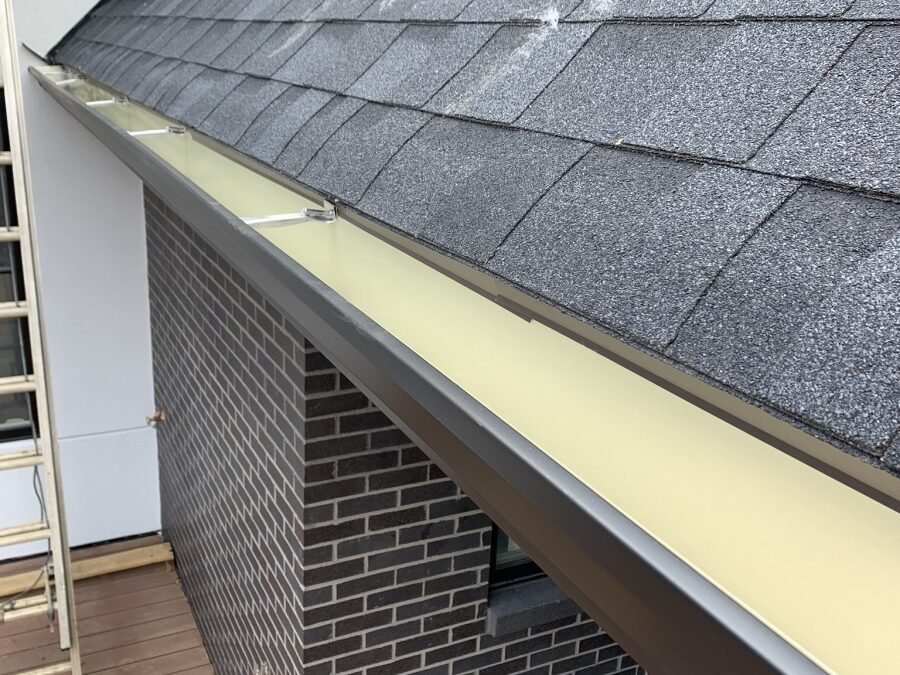Gutters are a vital component of your home’s defense against water damage, and one key element that often goes unnoticed is the gutter drip edge. In this blog post, we at Cardinal Gutters in Louisville, Kentucky, will delve into what a gutter drip edge is, its importance, and how it functions to protect your home. Whether you’re a seasoned homeowner or new to home maintenance, this post aims to provide valuable information about gutter drip edges.
What is a Gutter Drip Edge?
A gutter drip edge is a type of metal flashing installed along the edges of your roof. Its primary purpose is to guide water away from the fascia and into the gutters, preventing water from seeping into the roofing structure. By doing so, the drip edge plays a crucial role in preventing rot, mold, and other water-related damages. It ensures that water flows efficiently into the gutter system, enhancing its overall performance and durability.
The Importance of a Gutter Drip Edge
Protection Against Water Damage
The primary benefit of a gutter drip edge is its ability to protect your roof and home’s structure from water damage. Without a drip edge, water can run down the roof and behind the gutters, leading to damage to the fascia, soffit, and potentially the interior of your home. The drip edge directs water into the gutters, maintaining the structural integrity of your roof and preventing costly repairs.
Preventing Pest Infestations
A well-installed gutter drip edge acts as a barrier against pests. Without it, small animals, birds, and insects can enter through gaps between the roof and the fascia, leading to infestations and further damage. The drip edge seals these gaps, making it more challenging for pests to access your home.
Enhancing Gutter Efficiency
By ensuring that water flows directly into the gutters, a drip edge improves the efficiency of your gutter system. It helps manage water runoff, particularly during heavy rain, preventing gutters from overflowing and causing water to pool around your home’s foundation. This can prevent basement flooding and structural damage.
Types of Gutter Drip Edges
Gutter drip edges are available in various materials and styles, each offering unique benefits. Here are some common types:
Aluminum Drip Edge
Aluminum is a popular choice due to its lightweight nature and resistance to rust. It is easy to install and comes in various colors to match your home’s exterior. Aluminum drip edges are also cost-effective, making them a preferred option for many homeowners.
Galvanized Steel Drip Edge
Galvanized steel drip edges are known for their durability and strength. They are coated with zinc to prevent rust and corrosion. This type of drip edge is ideal for homes in areas with harsh weather conditions, as it can withstand heavy rainfall and strong winds.
Copper Drip Edge
Copper drip edges are the most durable and aesthetically pleasing option. Over time, copper develops a patina, giving it a unique and attractive appearance. While copper is more expensive than other materials, its longevity and visual appeal make it a worthwhile investment for many homeowners.
Vinyl Drip Edge
Vinyl drip edges are a budget-friendly option and easy to install. However, they are not as durable as metal drip edges and may not withstand extreme weather conditions as effectively. Vinyl is suitable for homeowners looking for a temporary or low-cost solution.
The Installation Process of Gutter Drip Edges
Installing a gutter drip edge requires precision and expertise. Here’s a general overview of the installation process:
Step 1: Preparing the Roof Edge
The first step involves preparing the roof edge by cleaning it and removing any debris. This ensures that the drip edge can be installed securely.
Step 2: Cutting the Drip Edge
The drip edge is then cut to the required length, ensuring it fits snugly along the roof edge. Precise cuts are essential to avoid gaps or overlaps.
Step 3: Positioning the Drip Edge
The drip edge is positioned along the roof edge, with the wider edge overhanging the roof and the narrower edge extending into the gutter. This ensures that water flows directly into the gutter system.
Step 4: Securing the Drip Edge
The drip edge is secured in place using roofing nails or screws. Ensuring the drip edge is flush against the roof and gutter is crucial to prevent gaps where water can seep through.
Step 5: Sealing the Edges
Finally, the edges are sealed using roofing cement or caulk to provide an additional layer of protection against water infiltration.
Maintenance Tips for Gutter Drip Edges
To ensure your gutter drip edge remains effective, regular maintenance is essential. Here are some tips to keep in mind:
Regular Inspections
Inspect the drip edge periodically to check for any signs of damage or wear. Look for rust, cracks, or any gaps between the drip edge and the roof.
Cleaning Debris
Keep the roof edge and gutters free from debris. Leaves, twigs, and other debris can accumulate and obstruct the flow of water, reducing the effectiveness of the drip edge.
Addressing Damage Promptly
If you notice any damage to the drip edge, address it promptly. Small issues can quickly escalate into major problems if left unattended.
Conclusion
Understanding the role and importance of a gutter drip edge is vital for maintaining the health and longevity of your home’s roof and gutter system. By directing water away from vulnerable areas, a drip edge helps prevent water damage, pest infestations, and enhances the overall performance of your gutters. At Cardinal Gutters in Louisville, Kentucky, we believe that an informed homeowner is a prepared homeowner. Regular inspections and maintenance can go a long way in ensuring your gutter drip edge continues to protect your home effectively.
Whether you are considering installing a new drip edge or simply want to understand more about your existing gutter system, this knowledge will empower you to make informed decisions for the betterment of your home.

